VOLVO V60 2013 User Guide
Manufacturer: VOLVO, Model Year: 2013, Model line: V60, Model: VOLVO V60 2013Pages: 422, PDF Size: 9.59 MB
Page 11 of 422
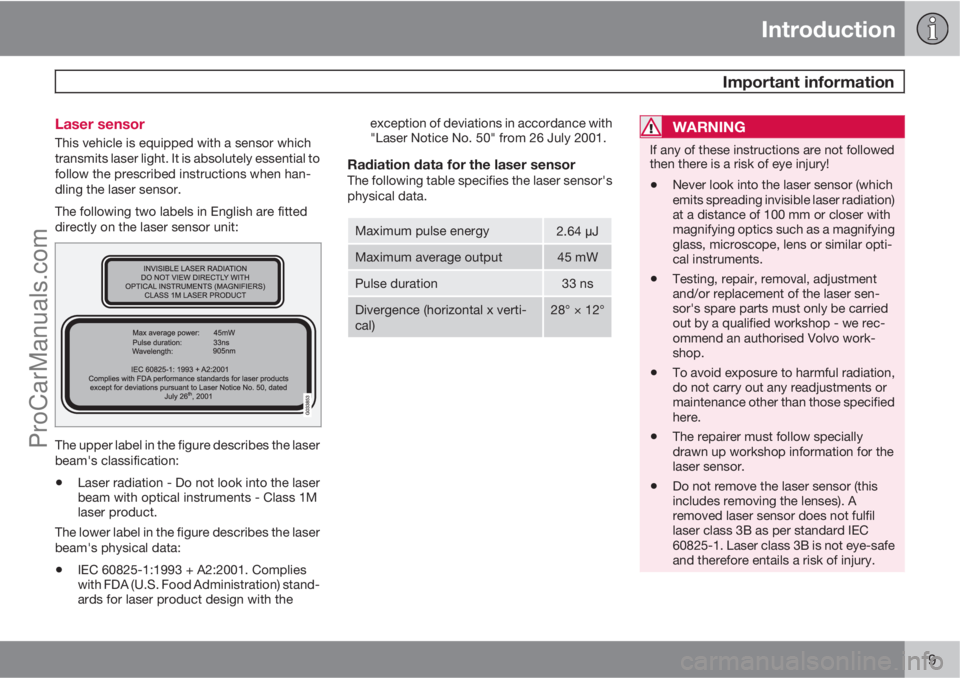
Introduction
Important information
9 Laser sensor
This vehicle is equipped with a sensor which
transmits laser light. It is absolutely essential to
follow the prescribed instructions when han-
dling the laser sensor.
The following two labels in English are fitted
directly on the laser sensor unit:
The upper label in the figure describes the laser
beam's classification:
•Laser radiation - Do not look into the laser
beam with optical instruments - Class 1M
laser product.
The lower label in the figure describes the laser
beam's physical data:
•IEC 60825-1:1993 + A2:2001. Complies
with FDA (U.S. Food Administration) stand-
ards for laser product design with theexception of deviations in accordance with
"Laser Notice No. 50" from 26 July 2001.
Radiation data for the laser sensorThe following table specifies the laser sensor's
physical data.
Maximum pulse energy2.64 �¦J
Maximum average output45 mW
Pulse duration33 ns
Divergence (horizontal x verti-
cal)28° × 12°
WARNING
If any of these instructions are not followed
then there is a risk of eye injury!
•Never look into the laser sensor (which
emits spreading invisible laser radiation)
at a distance of 100 mm or closer with
magnifying optics such as a magnifying
glass, microscope, lens or similar opti-
cal instruments.
•Testing, repair, removal, adjustment
and/or replacement of the laser sen-
sor's spare parts must only be carried
out by a qualified workshop - we rec-
ommend an authorised Volvo work-
shop.
•To avoid exposure to harmful radiation,
do not carry out any readjustments or
maintenance other than those specified
here.
•The repairer must follow specially
drawn up workshop information for the
laser sensor.
•Do not remove the laser sensor (this
includes removing the lenses). A
removed laser sensor does not fulfil
laser class 3B as per standard IEC
60825-1. Laser class 3B is not eye-safe
and therefore entails a risk of injury.
ProCarManuals.com
Page 12 of 422
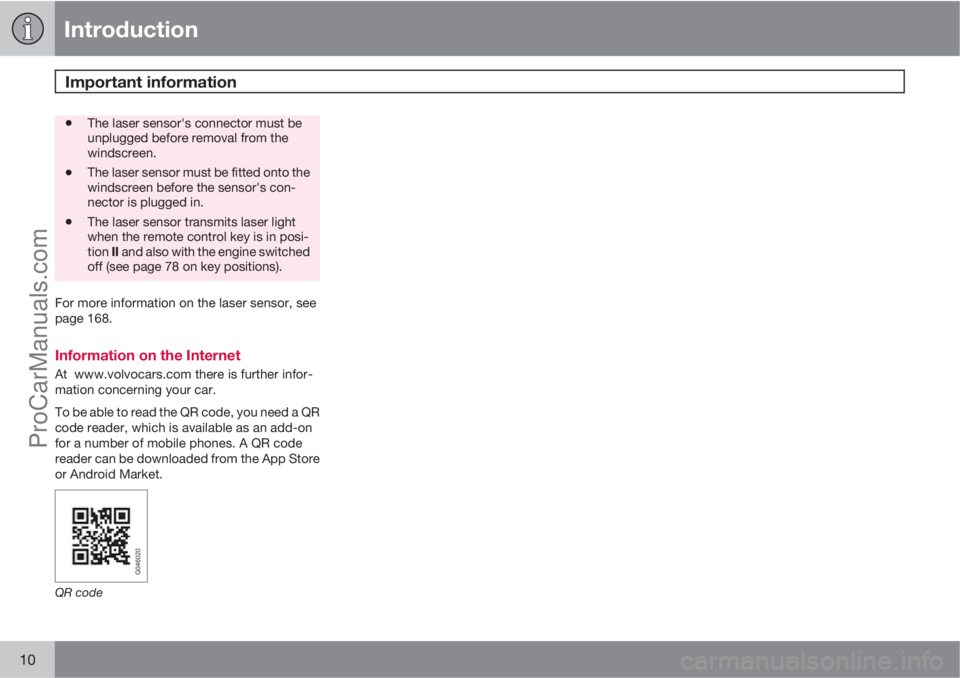
Introduction
Important information
10
•The laser sensor's connector must be
unplugged before removal from the
windscreen.
•The laser sensor must be fitted onto the
windscreen before the sensor's con-
nector is plugged in.
•The laser sensor transmits laser light
when the remote control key is in posi-
tion II and also with the engine switched
off (see page 78 on key positions).
For more information on the laser sensor, see
page 168.
Information on the Internet
At www.volvocars.com there is further infor-
mation concerning your car.
To be able to read the QR code, you need a QR
code reader, which is available as an add-on
for a number of mobile phones. A QR code
reader can be downloaded from the App Store
or Android Market.
QR code
ProCarManuals.com
Page 13 of 422
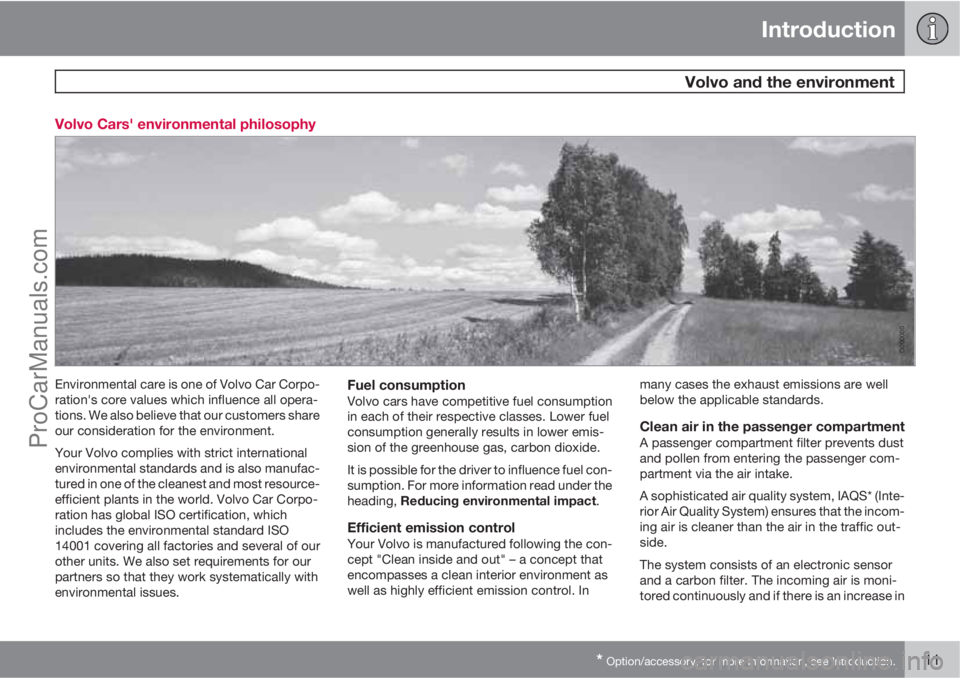
Introduction
Volvo and the environment
* Option/accessory, for more information, see Introduction.11 Volvo Cars' environmental philosophy
G000000
Environmental care is one of Volvo Car Corpo-
ration's core values which influence all opera-
tions. We also believe that our customers share
our consideration for the environment.
Your Volvo complies with strict international
environmental standards and is also manufac-
tured in one of the cleanest and most resource-
efficient plants in the world. Volvo Car Corpo-
ration has global ISO certification, which
includes the environmental standard ISO
14001 covering all factories and several of our
other units. We also set requirements for our
partners so that they work systematically with
environmental issues.Fuel consumptionVolvo cars have competitive fuel consumption
in each of their respective classes. Lower fuel
consumption generally results in lower emis-
sion of the greenhouse gas, carbon dioxide.
It is possible for the driver to influence fuel con-
sumption. For more information read under the
heading, Reducing environmental impact.
Efficient emission controlYour Volvo is manufactured following the con-
cept "Clean inside and out" – a concept that
encompasses a clean interior environment as
well as highly efficient emission control. Inmany cases the exhaust emissions are well
below the applicable standards.
Clean air in the passenger compartmentA passenger compartment filter prevents dust
and pollen from entering the passenger com-
partment via the air intake.
A sophisticated air quality system, IAQS* (Inte-
rior Air Quality System) ensures that the incom-
ing air is cleaner than the air in the traffic out-
side.
The system consists of an electronic sensor
and a carbon filter. The incoming air is moni-
tored continuously and if there is an increase in
ProCarManuals.com
Page 14 of 422
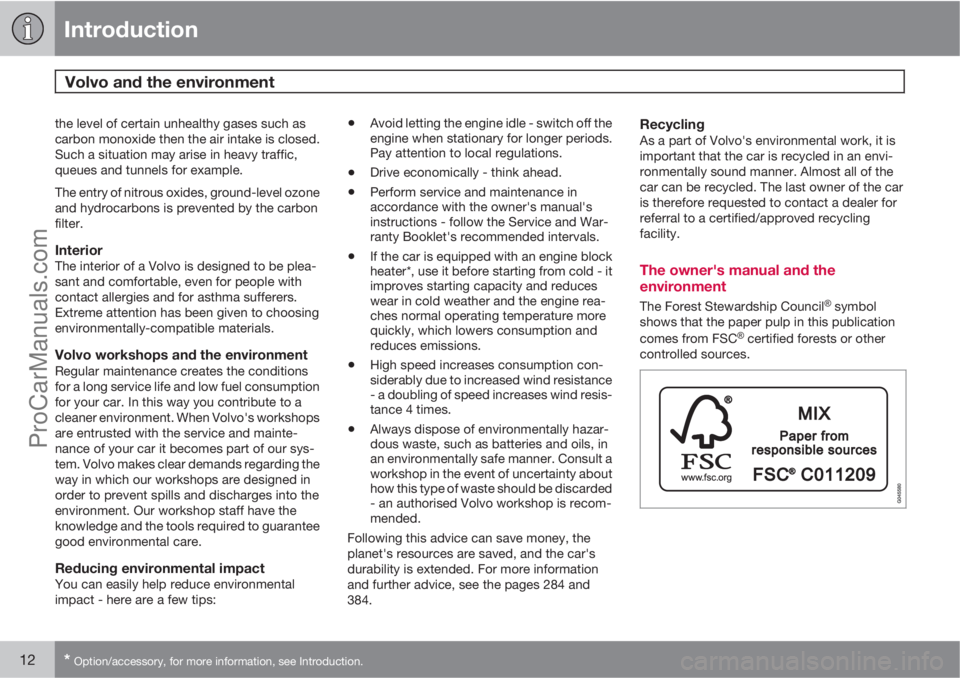
Introduction
Volvo and the environment
12* Option/accessory, for more information, see Introduction.
the level of certain unhealthy gases such as
carbon monoxide then the air intake is closed.
Such a situation may arise in heavy traffic,
queues and tunnels for example.
The entry of nitrous oxides, ground-level ozone
and hydrocarbons is prevented by the carbon
filter.
InteriorThe interior of a Volvo is designed to be plea-
sant and comfortable, even for people with
contact allergies and for asthma sufferers.
Extreme attention has been given to choosing
environmentally-compatible materials.
Volvo workshops and the environmentRegular maintenance creates the conditions
for a long service life and low fuel consumption
for your car. In this way you contribute to a
cleaner environment. When Volvo's workshops
are entrusted with the service and mainte-
nance of your car it becomes part of our sys-
tem. Volvo makes clear demands regarding the
way in which our workshops are designed in
order to prevent spills and discharges into the
environment. Our workshop staff have the
knowledge and the tools required to guarantee
good environmental care.
Reducing environmental impactYou can easily help reduce environmental
impact - here are a few tips:
•Avoid letting the engine idle - switch off the
engine when stationary for longer periods.
Pay attention to local regulations.
•Drive economically - think ahead.
•Perform service and maintenance in
accordance with the owner's manual's
instructions - follow the Service and War-
ranty Booklet's recommended intervals.
•If the car is equipped with an engine block
heater*, use it before starting from cold - it
improves starting capacity and reduces
wear in cold weather and the engine rea-
ches normal operating temperature more
quickly, which lowers consumption and
reduces emissions.
•High speed increases consumption con-
siderably due to increased wind resistance
- a doubling of speed increases wind resis-
tance 4 times.
•Always dispose of environmentally hazar-
dous waste, such as batteries and oils, in
an environmentally safe manner. Consult a
workshop in the event of uncertainty about
how this type of waste should be discarded
- an authorised Volvo workshop is recom-
mended.
Following this advice can save money, the
planet's resources are saved, and the car's
durability is extended. For more information
and further advice, see the pages 284 and
384.
RecyclingAs a part of Volvo's environmental work, it is
important that the car is recycled in an envi-
ronmentally sound manner. Almost all of the
car can be recycled. The last owner of the car
is therefore requested to contact a dealer for
referral to a certified/approved recycling
facility.
The owner's manual and the
environment
The Forest Stewardship Council�Ÿ symbol
shows that the paper pulp in this publication
comes from FSC
�Ÿ certified forests or other
controlled sources.
ProCarManuals.com
Page 15 of 422

Introduction
13ProCarManuals.com
Page 16 of 422
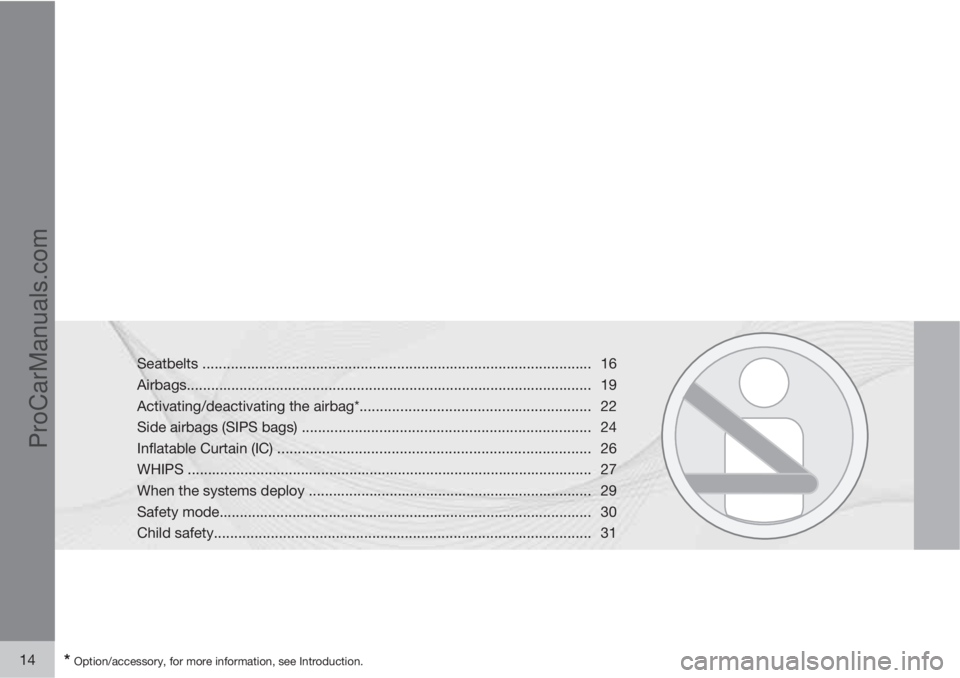
14* Option/accessory, for more information, see Introduction.
Seatbelts ................................................................................................ 16
Airbags.................................................................................................... 19
Activating/deactivating the airbag*......................................................... 22
Side airbags (SIPS bags) ....................................................................... 24
Inflatable Curtain (IC) ............................................................................. 26
WHIPS .................................................................................................... 27
When the systems deploy ...................................................................... 29
Safety mode............................................................................................ 30
Child safety............................................................................................. 31
ProCarManuals.com
Page 17 of 422
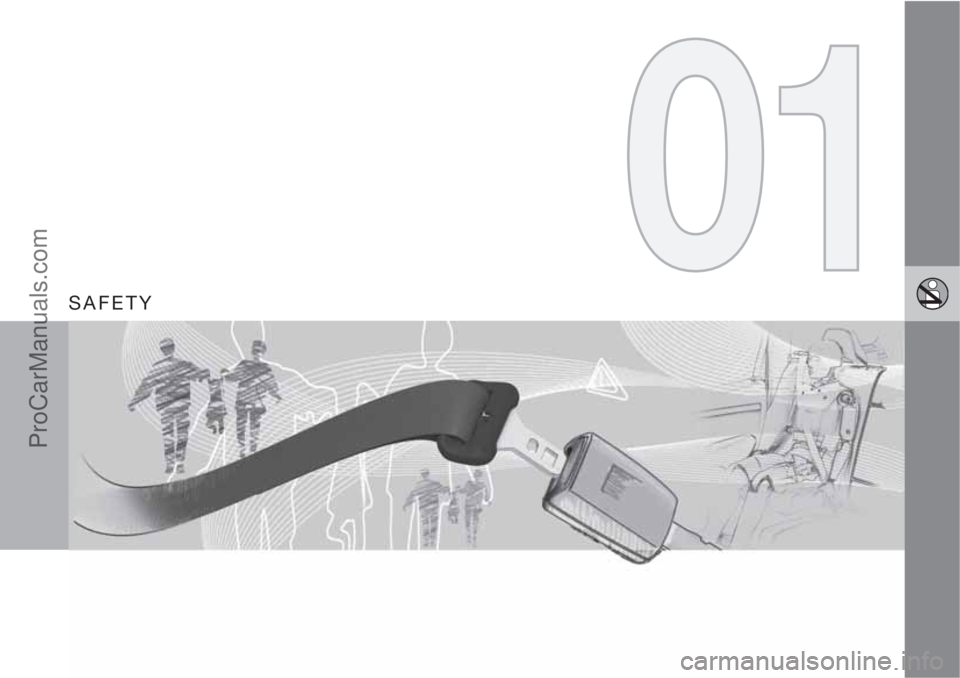
SAFETY
ProCarManuals.com
Page 18 of 422
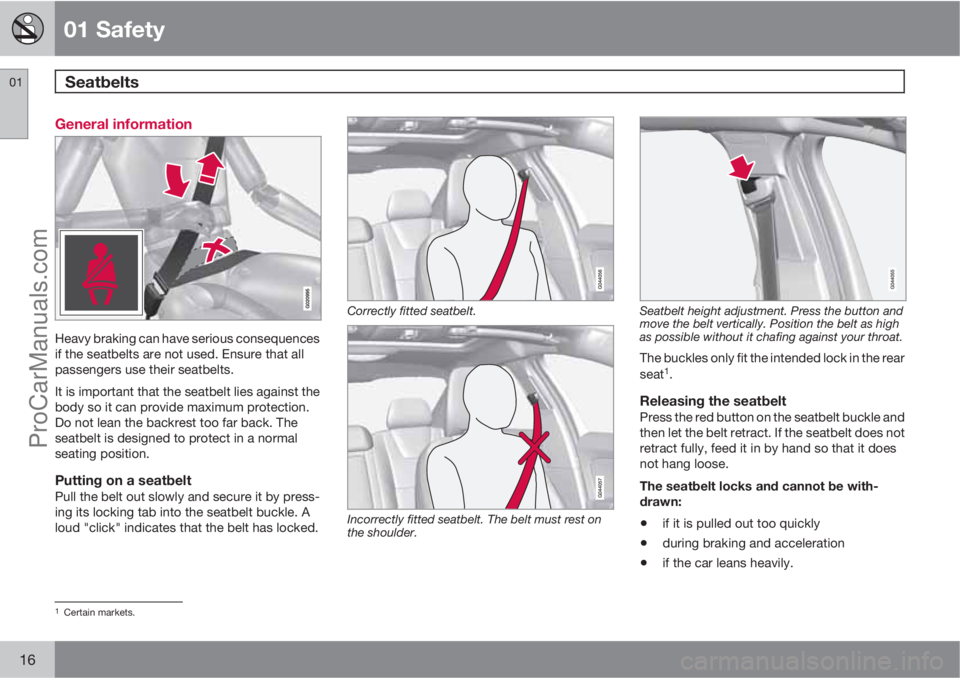
01 Safety
Seatbelts 01
16
General information
Heavy braking can have serious consequences
if the seatbelts are not used. Ensure that all
passengers use their seatbelts.
It is important that the seatbelt lies against the
body so it can provide maximum protection.
Do not lean the backrest too far back. The
seatbelt is designed to protect in a normal
seating position.
Putting on a seatbeltPull the belt out slowly and secure it by press-
ing its locking tab into the seatbelt buckle. A
loud "click" indicates that the belt has locked.
Correctly fitted seatbelt.
Incorrectly fitted seatbelt. The belt must rest on
the shoulder.
Seatbelt height adjustment. Press the button and
move the belt vertically. Position the belt as high
as possible without it chafing against your throat.
The buckles only fit the intended lock in the rear
seat1.
Releasing the seatbeltPress the red button on the seatbelt buckle and
then let the belt retract. If the seatbelt does not
retract fully, feed it in by hand so that it does
not hang loose.
The seatbelt locks and cannot be with-
drawn:
•if it is pulled out too quickly
•during braking and acceleration
•if the car leans heavily.
1Certain markets.
ProCarManuals.com
Page 19 of 422
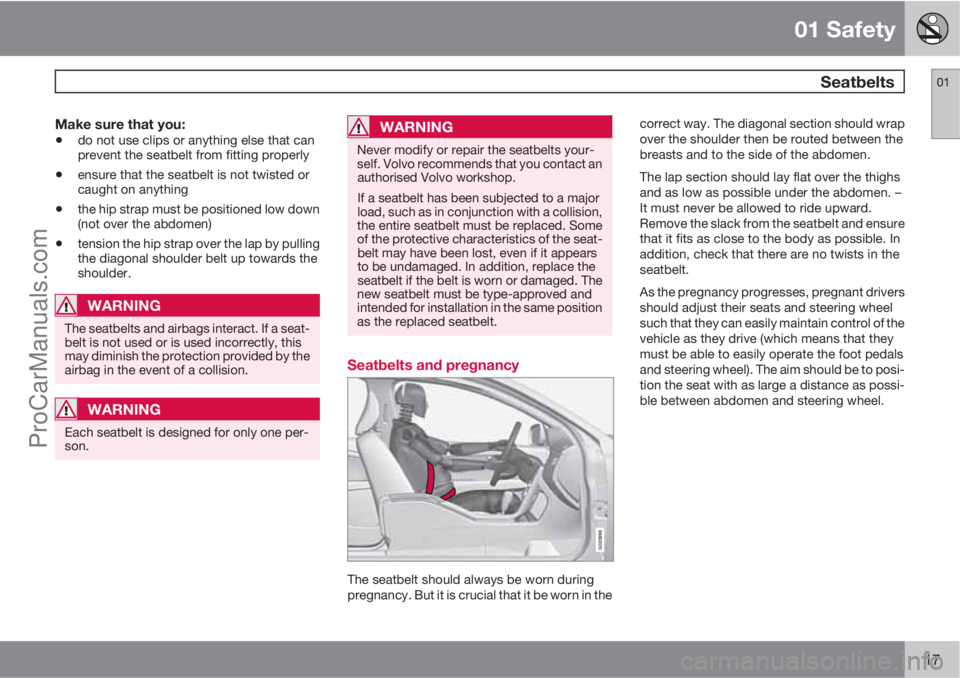
01 Safety
Seatbelts01
17
Make sure that you:
•do not use clips or anything else that can
prevent the seatbelt from fitting properly
•ensure that the seatbelt is not twisted or
caught on anything
•the hip strap must be positioned low down
(not over the abdomen)
•tension the hip strap over the lap by pulling
the diagonal shoulder belt up towards the
shoulder.
WARNING
The seatbelts and airbags interact. If a seat-
belt is not used or is used incorrectly, this
may diminish the protection provided by the
airbag in the event of a collision.
WARNING
Each seatbelt is designed for only one per-
son.
WARNING
Never modify or repair the seatbelts your-
self. Volvo recommends that you contact an
authorised Volvo workshop.
If a seatbelt has been subjected to a major
load, such as in conjunction with a collision,
the entire seatbelt must be replaced. Some
of the protective characteristics of the seat-
belt may have been lost, even if it appears
to be undamaged. In addition, replace the
seatbelt if the belt is worn or damaged. The
new seatbelt must be type-approved and
intended for installation in the same position
as the replaced seatbelt.
Seatbelts and pregnancy
G020998
The seatbelt should always be worn during
pregnancy. But it is crucial that it be worn in thecorrect way. The diagonal section should wrap
over the shoulder then be routed between the
breasts and to the side of the abdomen.
The lap section should lay flat over the thighs
and as low as possible under the abdomen. –
It must never be allowed to ride upward.
Remove the slack from the seatbelt and ensure
that it fits as close to the body as possible. In
addition, check that there are no twists in the
seatbelt.
As the pregnancy progresses, pregnant drivers
should adjust their seats and steering wheel
such that they can easily maintain control of the
vehicle as they drive (which means that they
must be able to easily operate the foot pedals
and steering wheel). The aim should be to posi-
tion the seat with as large a distance as possi-
ble between abdomen and steering wheel.
ProCarManuals.com
Page 20 of 422
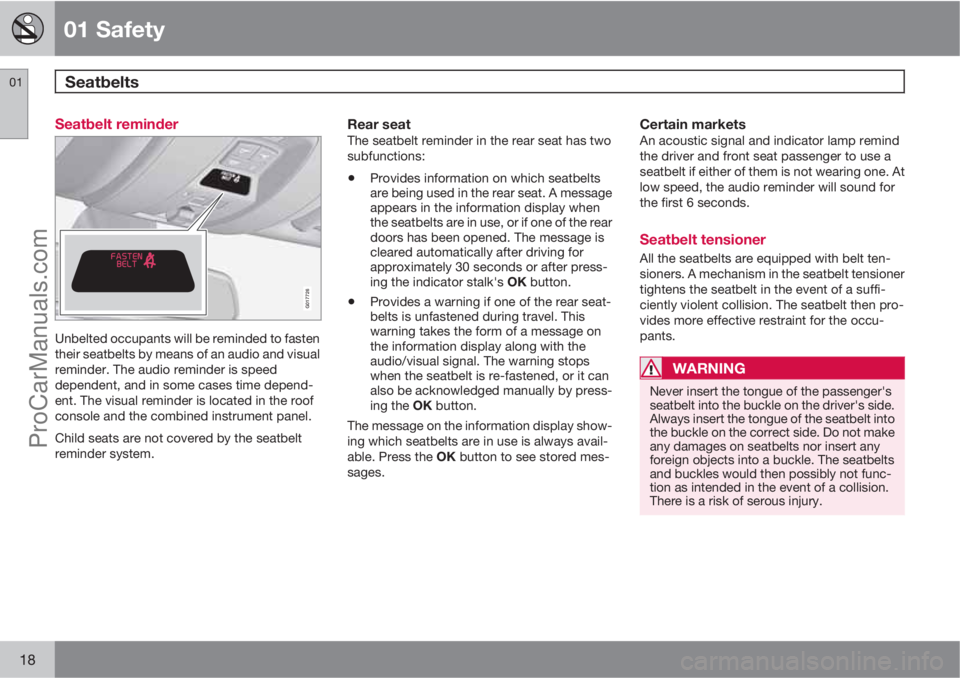
01 Safety
Seatbelts 01
18
Seatbelt reminder
G017726
Unbelted occupants will be reminded to fasten
their seatbelts by means of an audio and visual
reminder. The audio reminder is speed
dependent, and in some cases time depend-
ent. The visual reminder is located in the roof
console and the combined instrument panel.
Child seats are not covered by the seatbelt
reminder system.
Rear seatThe seatbelt reminder in the rear seat has two
subfunctions:
•Provides information on which seatbelts
are being used in the rear seat. A message
appears in the information display when
the seatbelts are in use, or if one of the rear
doors has been opened. The message is
cleared automatically after driving for
approximately 30 seconds or after press-
ing the indicator stalk's OK button.
•Provides a warning if one of the rear seat-
belts is unfastened during travel. This
warning takes the form of a message on
the information display along with the
audio/visual signal. The warning stops
when the seatbelt is re-fastened, or it can
also be acknowledged manually by press-
ing the OK button.
The message on the information display show-
ing which seatbelts are in use is always avail-
able. Press the OK button to see stored mes-
sages.
Certain marketsAn acoustic signal and indicator lamp remind
the driver and front seat passenger to use a
seatbelt if either of them is not wearing one. At
low speed, the audio reminder will sound for
the first 6 seconds.
Seatbelt tensioner
All the seatbelts are equipped with belt ten-
sioners. A mechanism in the seatbelt tensioner
tightens the seatbelt in the event of a suffi-
ciently violent collision. The seatbelt then pro-
vides more effective restraint for the occu-
pants.
WARNING
Never insert the tongue of the passenger's
seatbelt into the buckle on the driver's side.
Always insert the tongue of the seatbelt into
the buckle on the correct side. Do not make
any damages on seatbelts nor insert any
foreign objects into a buckle. The seatbelts
and buckles would then possibly not func-
tion as intended in the event of a collision.
There is a risk of serous injury.
ProCarManuals.com